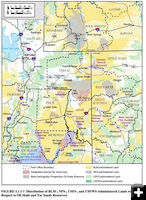BLM begins Oil Shale & Tar Sands public process
Draft Programmatic Environmental Impact Statement issued - Opens 90-day public review and comment period
by Bureau of Land Management
February 3, 2012
Washington, D.C. (February 3, 2012) – The Bureau of Land Management (BLM) has published the Notice of Availability (NOA) of the Draft Programmatic Environmental Impact Statement (PEIS) and Possible Land Use Amendments for Allocation of Oil Shale and Tar Sands Resources on Lands Administered by the BLM in Colorado, Utah and Wyoming. The publication opens a 90-day public review and comment period.
The Draft PEIS analyzes several alternatives for land allocation and resource management. Under the BLM’s Preferred Alternative identified in the Draft PEIS, the BLM would continue to support the research and development of hydrocarbon deposits in an environmentally responsible way that protects scarce water supplies in the arid West.
If the BLM decides to adopt the Preferred Alternative, 461,965 acres would be available for research and development of oil shale, a kerogen-rich rock (35,308 acres in Colorado; 252,181 acres in Utah; and 174,476 acres in Wyoming). In addition, 91,045 acres in eastern Utah would be available for activities related to tar sands, a type of hydrocarbon-wet sedimentary deposit.
"The preferred alternative continues our commitment to encouraging research, development, and demonstration projects so that companies can develop technologies that can lead to economic and commercial viability," said BLM Director Bob Abbey. "Because there are still many unanswered questions about the technology, water use, and impacts of potential commercial-scale oil shale development, we are proposing a prudent and orderly approach that could facilitate significant improvements to technology needed for commercial-scale activity. If oil shale is to be viable on a commercial scale, we must take a common-sense approach that encourages research and development first."
To date, technological and economic conditions have not combined to support a sustained commercial oil shale industry in the United States, and there is currently no commercial development of oil shale in the areas under review in the draft PEIS. Lands that would be open to oil shale development under the Preferred Alternative would be available for Research, Development, and Demonstration (RD&D) leases. The BLM could issue a commercial lease after a lessee satisfies the conditions of its RD&D lease and meets all federal regulations for conversion to a commercial lease.
Additionally, following the recommendations of the Government Accountability Office - which determined that several fundamental questions about oil shale technologies remain unanswered, including critical questions about water demands - the United States Geological Survey (USGS) is undertaking an analysis of baseline water resources conditions to improve the understanding of groundwater and surface water systems that could be affected by commercial-scale oil shale development.
Oil shale is a term used to describe a wide range of fine-grained, sedimentary rocks that contain solid bituminous materials called kerogen. It should not be confused with "shale oil," which is not addressed by the draft PEIS. Kerogen, which is organic matter derived mainly from aquatic organisms, releases petroleum-like liquids when subjected to extremely high temperatures – more than 750 degrees. Developers have been trying to produce oil from this rock in an economically-viable way for more than a century. The majority of U.S. oil shale (and the world’s largest oil shale deposit) is found in the Green River Formation in Colorado, Utah, and Wyoming.
Tar sands are sedimentary rocks containing a heavy hydrocarbon compound called bitumen. They can be mined and processed to extract the oil-rich bitumen, which is then refined into oil. However, unlike the oil sands deposits in Canada, oil is not currently produced from tar sands on a significant commercial level in the United States. Additionally, the U.S. tar sands are hydrocarbon wet, whereas the Canadian oil sands are water wet. This difference means that U.S. tar sands will require different processing techniques.
Any new land allocation decisions made on the basis of the Final PEIS would replace the land allocation decisions made in 2008 that proposed making up to 2 million acres of public lands available for commercial oil shale leasing in Utah, Colorado, and Wyoming and 431,000 acres available for tar sands leasing in Utah. Some Western communities argued that the 2008 PEIS and Record of Decision would have prematurely allowed commercial leasing without technologies having been proven viable and without a clear understanding of impacts on scarce Western water supplies. In response to those concerns and in settlement of litigation, the agency agreed to reconsider the 2008 land allocation decisions.
A 90-day public review and comment period began on February 3, 2012 and is scheduled to end on May 4, 2012.
Public meetings on the Draft PEIS will also be held in Rifle, CO; Rock Springs, WY; Salt Lake City; and Vernal, UT. The public will be notified of the dates and times of these meetings at least 15 days in advance via local media and the project website.
Written comments on the Draft PEIS may be submitted by any of the following methods:
Website – Using the online comment form available on the project Website:
http://ostseis.anl.gov. (This is the preferred method of commenting.)
• Mail – Addressed to:
Oil Shale and Tar Sands Resources Draft Programmatic EIS
Argonne National Laboratory
9700 South Cass Avenue—EVS/240
Argonne, IL 60439.
Before including your address, telephone number, e-mail address, or other personal identifying information in your comment, you should be aware that your entire comment–including your personal identifying information–may be made publicly available at any time. While you can ask us in your comment to withhold your personal identifying information from public review, we cannot guarantee that we will be able to do so.
To read the BLM’s Federal Register Notice of Availability click here: http://www.ofr.gov/(X(1)S(m3yumwi5wz0jcjppa534vfzn))/OFRUpload/OFRData/2012-02412_PI.pdf
To read the Draft PEIS click here: http://ostseis.anl.gov./documents/peis2012/index.cfm
|
